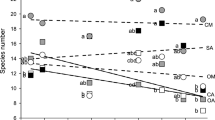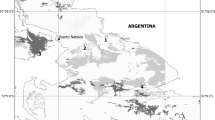Abstract
Terrestrial herbs are important ecological components in tropical agroforests, but little is known about how they are affected by agricultural management. In cacao agroforests of Central Sulawesi, Indonesia, we studied the change in herb species richness, cover, and biomass over 3 years in 86 subplots subjected to high and low weeding frequency as well as fertilized and non-fertilized treatments. We recorded 111 species with rapid changes in species composition between the 3 years. Species richness increased sharply in the 2nd year, presumably as a result of changes in the management with the experimental regimes, and decreased in the 3rd, probably due to competitive exclusion. Species richness, cover, and biomass were all significantly higher in the infrequently weeded plots than in the frequently weeded ones, but there were only slight responses to the fertilization treatment. An indicator species analysis recovered 45 species that were typical for a given year and a further eight that were typical for certain treatments, but these species showed no clear patterns relative to their ecology or biogeography. We conclude that the herb assemblages in cacao agroforests are quite resilient against weeding, but that the cover of species shifts rapidly in response to management.




Similar content being viewed by others
References
Abrahamczyk S, Kessler M, Putra D, Waltert M, Tscharntke T (2008) The value of differently managed cacao plantations for forest birds conservation in Sulawesi, Indonesia. Bird Cons Internat 18:349–362
Aguillar V, Staver C, Milberg P (2003) Weed vegetation response to chemical and manual selective ground cover management in a shaded coffee plantation. Weed Res 43:68–75
Bakker JD (2008) Increasing the utility of indicator species analysis. J Appl Ecol 45:1829–1835
Banful BK, Hauser S, Ofori K, Kumaga FK (2007) Weed biomass dynamics in planted fallow systems in the humid forest zone of southern Cameroon. Agroforest Syst 71:49–55
Bhagwat SA, Willis KJ, Birks HJB, Whittaker RJ (2008) Agroforestry: a refuge for tropical biodiversity? Trends Ecol Evol 5:261–267
Bisseleua D, Herve B, Vidal S (2008) Plant biodiversity and vegetation structure in traditional cocoa forest gardens in southern Cameroon under different management. Biodiv Conserv 17:1821–1835
Bloker BM, Brooks ME, Clark CJ, Geange SW, Poulsen JR, Stevens MHH, White JSS (2009) Generalized linear mixed models: a practical guide for ecology and evolution. Trends Ecol Evol 24:127–135
Bobo KS, Waltert M, Sainge NM, Njokagbor J, Fermon H, Mühlenberg M (2006) From forest to farmland: species richness patterns of trees and understory plants along a gradient of forest conversion in Southwestern Cameroon. Biodiv Conserv 15:4097–4117
Bos MM, Dewenter IS, Tscharntke T (2007) The contribution of cacao agroforests to the conservation of lower canopy ant and beetle diversity in Indonesia. Biodiv Conserv 16:2429–2444
Chiarucci A, Enright NJ, Perry GLW, Miller BP, Lamont BB (2003) Performance of nonparametric species richness estimators in high diversity plant community. Divers Distrib 9:283–295
Cicuzza D, Kessler M, Clough Y, Pitopang R, Leitne D, Tjitrosoedirdjo SS (2011) Conservation value of cacao agroforests for terrestrial herbaceous plants in Central Sulawesi, Indonesia. Biotropica. doi:10.1111/j.1744-7429.2010.00741.x
Clarke KR, Somerfield PJ, Gorley RN (2008) Testing of null hypothesis in explanatory community analyses: similarity profile and biota-environment linkage. J Exp Mar Boil Ecol 366:56–69
Clough Y, Putra DD, Pitopang R, Tscharntke T (2009) Local and landscape factors determine functional bird diversity in Indonesian cacao agroforestry. Biol Conserv 142:1032–1041
Clough Y, Barkmann J, Juhrbandt J, Kessler M, Wanger TC, Anshary A, Buchori D, Cicuzza D, Darras K, Putra DD, Erasmi S, Pitopang R, Schmidt C, Schulze CH, Seidel D, Steffan-Dewenter I, Stenchly K, Vidal S, Weist M, Wielgoss AC, Tscharntke T (2011) Combining high biodiversity with high yields in tropical agroforests. PNAS 108:8311–8316
Colwell RK (2008) EstimateS: Statistical estimation of species richness and shared species from samples. Version 8.0.0 User’s guide and application. Available at: http://purl.oclc.org/estimates
Donald PF (2004) Biodiversity impacts of some agricultural commodity production systems. Conserv Biol 18:17–37
Efthimiadou AP, Anestis C, Dimitrios BJ, Efthimiadis P (2009) The phenomenon of crop-weed competition; a problem or a key for sustainable weed management? J Food Agric Environ 7:861–868
Erasmi S, Twele A, Ardiansyah M, Malik A, Kappas SM (2004) Mapping deforestation and land cover conversion at the rainforest margin in Central Sulawesi, Indonesia. EARSeL e Proc 3:388–397
Esmail S, Oelbermann M (2011) The impact of climate change on the growth of tropical agroforestry tree seedlings. Agroforest Syst. doi:10.1007/s10457-011-9424-1
Faria D, Baumgarten J (2007) Shade cacao plantations (Theobroma cacao) and bat conservation in southern Bahia. Brazil Biodiv Conserv 16:291–312
Greenberg R, Bichier P, Angón AC (2000) The conservation value for birds of cacao plantations with diverse planted shade in tabasco. Mexico Anim Conserv 3:105–112
Herzog SK, Kessler M, Cahill TM (2002) Estimating species richness of tropical bird communities from rapid assessment data. Auk 119:749–769
Jose S (2009) Agroforestry for ecosystem services and environmental benefits: an overview. Agroforest Syst 76:1–10
Kessler M, Kessler PJA, Gradstein SR, Bach K, Schmull M, Pitopang R (2005) Tree diversity in primary forest and different land use systems in Central Sulawesi, Indonesia. Biodiv Conserv 14:547–560
Klein AM, Dewenter IS, Tscharntke T (2003) Fruit set of highland coffee increases with the diversity of pollinating bees. Proc R Soc London B 270:955–961
Lozada T, Koning de GHJ, Kessler M, Klein AM, Tscharntke T (2008) Geographical range size of tropical plants influences their response to anthropogenic activities. Div Distrib 14: 59–68
Mc Cune Mefford (1999) PC-ORD Multivariate analysis of ecological data. Version 5. MjM Software Design, Gleneden Beach OR
Mouillon D, Culioli JM, Chi TD (2002) Indicator species analysis as a test of non-random distribution of species in the context of marine protected areas. Envir Conserv 29:385–390
Oksanen J, Kindt R, Legendre P, O’Hara B, Stevens MHH (2007) Vegan: community ecology package. R package version 1.8–8 http://r-forge.rproject.org/project/vegan/
Partey ST (2011) Effect of pruning frequency and pruning height on the biomass production of Tithonia diversifolia (Hemsl) A. Gray. Agroforest Syst. doi:10.1007/s10457-010-9367-y
Perfecto I, Snelling R (1995) Biodiversity and the transformation of a tropical agroecosystem: ants in coffee plantations. Ecol Appl 5:1084–1097
Philpott SM, Armbrecht I (2006) Biodiversity in tropical agroforests and the ecological role of ants and ant diversity in predatory function. Ecol Entomol 31:369–377
Philpott SM, Arendt WJ, Armbrecht I, Bichier P, Diestch TV, Gordon C, Greenberg R, Perfecto I, Reynoso-Santos R, Soto-Pinto L, Tejeda-Cruz C, Williams-Lenera G, Valenzuela J, Zolotoff JM (2008) Biodiversity loss in Latin American coffee landscape: review of the evidence on ants, birds and trees. Conserv Biodiv 22:1093–1105
R development core team (2007) R: a language and environment for statistical computing. R Foundation for Statistical Computing, Vienna, Austria. http://www.r-project.org
Rice RA, Greenberg R (2000) Cacao cultivation and the conservation of biological diversity. Ambio 29:167–173
Saito K, Linquist B, Johnson DE, Phengchanh S, Shiraiwa T, Horie T (2008) Planted legume fallows reduce weeds and increase soil N and P contents but not upland rice yields. Agroforest Syst 74:63–72
Siebert SF (2000) Survival and growth of rattan intercropped with coffee and cacao in the agroforests of Indonesia. Agroforest Syst 50:95–102
Smiley SL, Kroschel J (2010) Yield development and nutrient dynamics in cocoa-gliricidia agroforests of Central Sulawesi, Indonesia. Agroforest Syst 78:97–114
Steffan-Dewenter I, Kessler M, Barkmann J, Bos MM, Buchori D, Erasmi S, Faust H, Gerold G, Glenk K, Gradstein RS, Guhardja E, Harteveld M, Hertel D, Höhn P, Kappas M, Köhler S, Leuschner C, Maertens M, Marggraf R, Migge-Kleian S, Mogea J, Pitopang R, Schafer M, Schwarze S, Sporn SG, Steingrebe A, Tjitrosoedirdjo SS, Tjitrosoedirdjo S, Twele A, Weber R, Woltmann L, Zeller M, Tscharntke T (2007) Tradeoffs between income, biodiversity, and ecosystem functioning during tropical rainforest conversion and agroforestry intensification. PNAS 12:4973–4978
The Nature Conservation (2004) Lore Lindu national park management plan 2004–2029
Tscharntke T, Sekercioglu CH, Dietsch TV, Sodhi NS, Hoehn P, Tylianakis JM (2008) Landscape constraints of functional diversity of birds and insects in tropical agroecosystems. Ecology 89:944–951
Wanger TC, Saro A, Iskandar DT, Brook BW, Sodhi NS, Clough Y, Tscharntke T (2009) Conservation value of cacao agroforestry for amphibians and reptiles in Southeast Asia: combining correlative models with follow-up field experiments. J Appl Ecol 46:823–832
Watanabe A, Takada Sarno H, Afandi, Adachi T, Oki Y, Senge M (2007) Assessment of degradation and generation of humus in a coffee soil affected by weed cover by means of a stable carbon isotopic ratio. Europ J Soil Sci 58:1042–1049
Weist M, Tscharntke T, Sinaga MH, Maryanto I, Clough Y (2010) Effect of distance to forest and habitat characteristics on endemic versus introduced rat species in agroforest landscapes of Central Sulawesi, Indonesia. Mammalian Biol 75:567–571
Wielgoss A, Tscharntke T, Bucheri D, Fiala B, Clough Y (2010) Temperature and a dominant dolichoderine and species affect and diversity in Indonesian cacao plantations. Agr Ecosyst Environ 135:253–259
Zapfack L, Engwald S, Sonke B, Achoundong G, Madong BA (2002) The impact of land conversion on plant biodiversity in the forest zone of Cameroon. Biodiv Conserv 11:2047–2061
Acknowledgments
This study was funded by the German Research Foundation (DFG), grant SFB-552 STORMA (Stability of Rainforest Margins) http://www.uni-goettingen.de/de/40515.html. Herb species identification was conducted partly at the Herbarium of Leiden supported by Synthesys NL-TAF 3536. We thank Stefan Köhler, head of the laboratory at Tadulako University, Adam Malik, Wolfram Lorenz, Surya Tarigan, Muhammad Sigit, and all plantation owners for their help.
Author information
Authors and Affiliations
Corresponding author
Electronic supplementary material
Below is the link to the electronic supplementary material.
Rights and permissions
About this article
Cite this article
Cicuzza, D., Clough, Y., Tjitrosoedirdjo, S.S. et al. Responses of terrestrial herb assemblages to weeding and fertilization in cacao agroforests in Indonesia. Agroforest Syst 85, 75–83 (2012). https://doi.org/10.1007/s10457-011-9456-6
Received:
Accepted:
Published:
Issue Date:
DOI: https://doi.org/10.1007/s10457-011-9456-6




